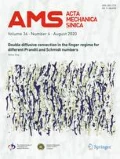Abstract
The damping coefficient of capillary waves due to the evaporation-condensation process at the interface of the two phases of a fluid is evaluated. To highlight the mechanism of the effect of heat and mass transfer across the interface between regions of liquid and vapor, potential flow of incompressible fluids are assumed. Thus other mechanisms of damping are neglected. To fascilitate the analysis, the method of multiple-scale is employed in the analysis, even though the problem is linear.
Similar content being viewed by others
References
Hsich DY. Effects of heat and mass transfer on Rayleigh-Taylor stability.Trans ASME, 1972, 94D: 156–162
Hsieh DY, Ho SP. Wave and Stability in Fluids. Singapore: World Scientific, 1994
Nayfeh A. Perturbation Methods. New York: Wiley, 1973
Author information
Authors and Affiliations
Rights and permissions
About this article
Cite this article
Hsieh, DY. On damping coefficient due to phase transformation. Acta Mech Sinica 19, 204–207 (2003). https://doi.org/10.1007/BF02484480
Received:
Revised:
Issue Date:
DOI: https://doi.org/10.1007/BF02484480



